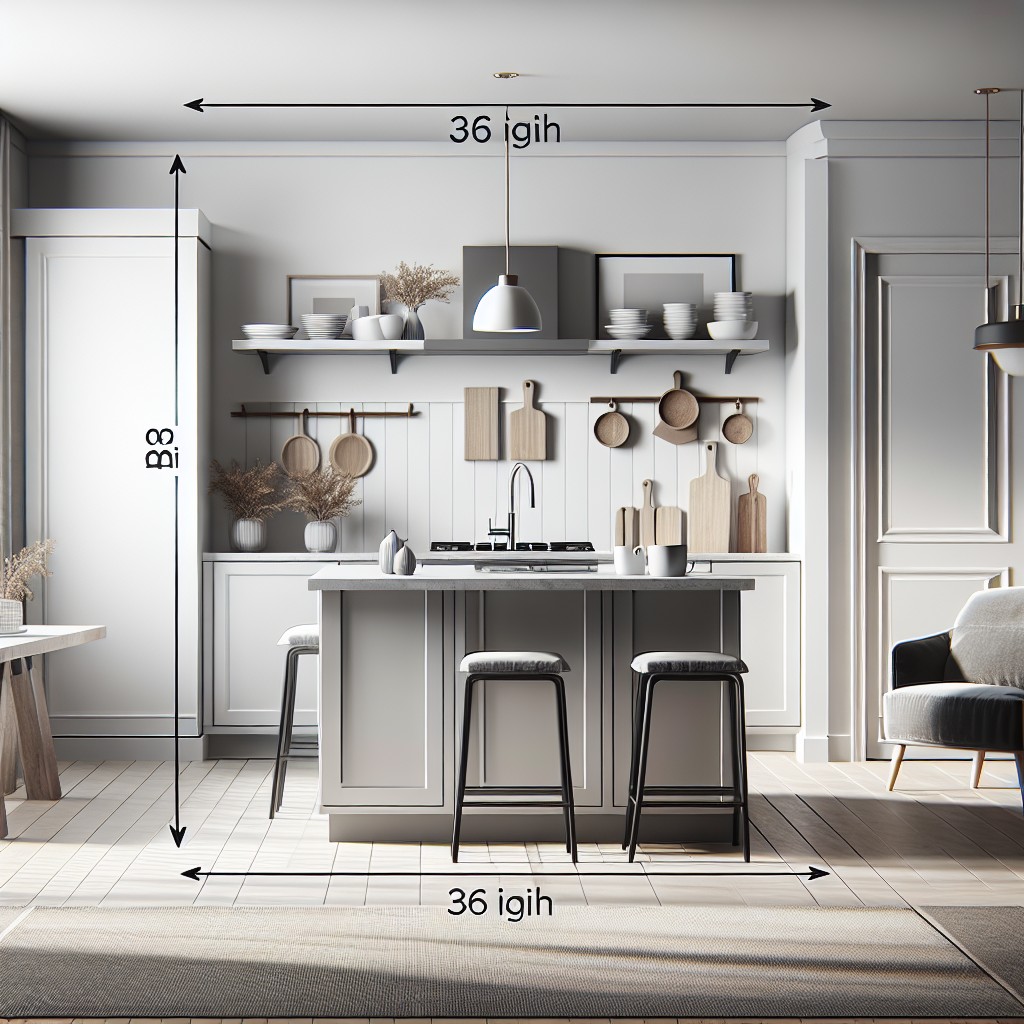Last updated on
Uncover the ideal height for your kitchen island to maximize comfort and functionality in today’s post.
Key takeaways:
- Ideal kitchen island height is around 36 inches
- Standard height creates a unified workspace and is visually appealing
- It’s best to match the kitchen island height with the countertops
- Counter-height kitchen islands offer seamless integration and ergonomic comfort
- Bar-height kitchen islands create a chic dining spot with extra storage
What's Inside
STANDARD KITCHEN ISLAND HEIGHT

When discussing the heights of kitchen islands, ‘standard’ is a term often mentioned. The typical height for a kitchen island that aligns with counters is around 36 inches. This measurement is neither arbitrary nor set in stone; rather, it’s ergonomically designed to match the average person’s standing elbow height, ensuring comfort during food preparation.
It’s crucial to note that this height suits a variety of tasks, from chopping vegetables to rolling out pastry dough, making it an ideal choice for a multi-functional surface. Furthermore, this elevation seamlessly blends with most residential kitchen counters, creating a unified workspace that is both visually appealing and practical.
Consider the base cabinet height, which is usually 34.5 inches, paired with a standard countertop thickness of 1.5 inches, culminating in the 36-inch figure. However, depending on specific needs or custom designs, the height can be adjusted. For instance, individuals who are taller or shorter than average may prefer a custom height for maximum comfort.
Keep in mind, though, that venturing too far from the standard can impact the resale value of a home. Most homebuyers expect a certain degree of uniformity in kitchen design, and deviations from the norm can sometimes be viewed as inconvenient rather than innovative.
Should a Kitchen Island Be the Same Height As Countertops?
In most kitchens, the island and countertops share a unified height, set at the standard 36 inches. This consistent elevation simplifies tasks like chopping, mixing, and meal prep, ensuring a seamless workflow across the entire kitchen space. This height keeps everything within an arm’s reach and creates a cohesive visual line that can make a kitchen look more organized and spacious.
Additionally, a uniform height allows for the countertop material to be the same across all surfaces, offering a streamlined aesthetic and sometimes cost savings by purchasing slabs in bulk.
However, remember that this standard works well for the average person and if you’re particularly tall or short, you might consider customizing the height for ergonomic comfort. Ultimately, functionality should be the guiding principle, ensuring the kitchen is a pleasure to use for everyone in your household.
Advantages of a Counter-Height Kitchen Island
Seamless Integration: Aligning with standard countertop heights creates a uniform surface throughout the kitchen, facilitating an uninterrupted workflow and offering greater surface area for prep.
Cohesive Design: Matching the island to the counters offers a sleek, cohesive look that appeals to those with an eye for streamlined aesthetics.
Accessibility: A counter-height island is accessible to all members of the family, including children and those in wheelchairs, ensuring that the kitchen is a welcoming space for everyone.
Ergonomic Comfort: Standing to chop, mix, or knead at this height reduces strain on the back, as it aligns with the natural position of the arms and hands when performing kitchen tasks.
Versatile Seating Options: Stools for counter-height islands are readily available and come in a variety of styles to complement any kitchen décor, making the selection process straightforward.
Advantages of a Bar-Height Kitchen Island
Elevating the dining experience, a bar-height kitchen island, typically standing at about 42 inches, offers a casual yet chic dining spot that’s perfect for quick meals or enjoying cocktails with friends.
The additional height can create a clear division between the kitchen’s prep area and the dining space, allowing for a tidy visual separation that maintains the kitchen’s workflow while entertaining guests.
Plus, for smaller kitchens, the height creates an illusion of space, making the room feel more open.
Another perk is the potential for extra storage underneath, providing a clever solution for tucking away less frequently used items.
Moreover, standing tasks like chopping become more comfortable for taller individuals who may find standard counter heights too low, reducing the need to hunch over and consequently alleviating back strain.
How To Choose the Right Stool Height for Your Counter
When selecting stools for your kitchen island, consider the distance from the seat to the island surface. A comfortable seating position typically requires a 10- to 12-inch gap. Therefore, for a standard counter height of 36 inches, stools with a seat height of 24 to 26 inches are ideal.
If your island stands at bar height, typically around 42 inches tall, look for stools that are around 30 inches in seat height to maintain that ergonomic space between seat and counter.
It’s additionally wise to measure the space under the island to ensure stools fit comfortably when not in use, particularly if your island features a smaller overhang. For maximizing the utility and comfort, opt for stools with backs and footrests if the intended use includes extended periods of sitting.
Remember to account for any additional features like swivel functions or adjustable heights that can impact how the stool fits in the designated space. These considerations will ensure your kitchen island is both functional and a cozy hub for gathering.




